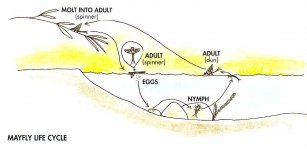S
Sean
New member
- Joined
- Jan 5, 2011
- Messages
- 6
I've been reading through these forums for a couple days now and as a new fly fisher it seemed like a good place to join up. I live in the Reading, PA area and have convenient access to the Tulpehocken and other creeks in the area.
I have virtually no fly fishing experience. I took a lesson for fun with my dad over the summer that taught us some basic casting mechanics and bought a fly rod the next day. Since then I've gotten out on the water a few times with the rod but haven't had any success yet, still waiting for that illusive 'first fish'.
I spent most of the summer bass fishing and night fishing for catfish and by the time fall came around I still didn't really know what I was doing with my fly rod. In the fall I learned about all the great trout fishing streams in the area and about the Tulpehocken (I'm new to the area).
I got my first pair of waders for Christmas and a fly tying kit, and got out on the Tulpehocken to explore a little bit. I've been itching to keep getting out on the water with the new gear but I'm not really sure if someone with my experience level can really have much success with it being winter time and all.
As you might imagine I have tons of questions so I'll try not to bombard you guys with them all at once, looking forward to talking with everyone.
I have virtually no fly fishing experience. I took a lesson for fun with my dad over the summer that taught us some basic casting mechanics and bought a fly rod the next day. Since then I've gotten out on the water a few times with the rod but haven't had any success yet, still waiting for that illusive 'first fish'.
I spent most of the summer bass fishing and night fishing for catfish and by the time fall came around I still didn't really know what I was doing with my fly rod. In the fall I learned about all the great trout fishing streams in the area and about the Tulpehocken (I'm new to the area).
I got my first pair of waders for Christmas and a fly tying kit, and got out on the Tulpehocken to explore a little bit. I've been itching to keep getting out on the water with the new gear but I'm not really sure if someone with my experience level can really have much success with it being winter time and all.
As you might imagine I have tons of questions so I'll try not to bombard you guys with them all at once, looking forward to talking with everyone.





